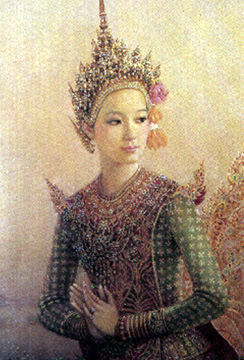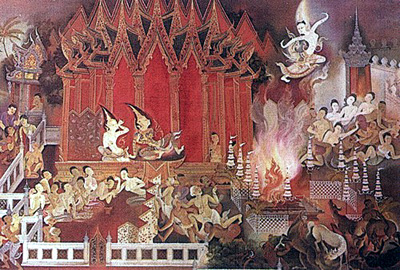|
There is a romantic fairytale in Southeast Asia about love between a human and a mythological creature, who was half-human, half bird and lived in the Himaphan forest. The seven Kinaree princesses always bathed in the forest at the Anodass pond which had crystal-clear water.
The seven Kinaree princesses removed their wings and tails while they took a bath. Pran Boon, the great hunter and a friend of the king Prasuthon, stole Manorah's wings and tail, caught her with a lasso and offered her as a gift to Prasuthon. Both immediately fell in love. Prasuthon hid the wings and tail of Manorah from her for fear that one day she might fly away from him. The king also appointed her to be queen.
The royal advisor was dissatisfied because he wanted his daughter to be the queen. When Prasuthon left the city to fight for his kingdom, the royal advisor told Prasuthon's mother that Manorah brought bad luck to and all the omens would disappear after Manorah's death. Although the king's mother loved Manorah, as she was a great dancer; she wanted to protect her son from bad luck, because Manorah was not a pure human. They decided to burn her alive.
Manorah asked for the last chance to dance for her mother-in-law to worship the fire. In order to do this dance, she had to wear her wings and tail. After she completed the dance, she fled and left a message for Prasuthon that she would wait for him at the KrailasMountain but he had to meet her before seven years, seven months and seven days, or else they would have no chance to meet each other again.
Prasuthon was victorious and returned to find that his wife had fled to the KrailasMountain. He asked Pran Boon to lead him to Himaphan forest. The journey took him seven years, seven months and six days to reach the bottom of KrailasMountain. However, he still could not reach her because her palace was on the cliff. In order to meet her in time, he had to catch the foot of a big bird to fly to Manorah's palace.
The king of Nakorn Kinaree kingdom wanted Prasuthon to prove his love and sincerity to Manorah. If he really loved her, he should be able to identify her from six sisters, who all had the same physical features. Prasuthon could not identify Manorah by her physical features, but he could remember the ring he gave to her and which she still wore until the day they would meet each other again. Finally, they meet each other again and stay together forever.

Manorah folk dance in southern Thailand is often performed by minority ethic groups, Manorah dance and drama includes classical gesture (Norah Maebot) and interpretive gesture (Norah Thambot). Manorah emphasizes the dance rather than the stories which derive from Ramayana and Mahabharata epics. All performers of Manorah are men, who cross-dress to play female roles.
Manorah or Norah is a traditional Malaysian folk dance drama. Some scholars in Malaysia believed that Manorah is a primitive performing art, originating in Southern Thailand, and could have evolved from the ritual of propitiation of hunters. Nowadays, Manorah is largely performed as an art form for the people.

The word Norah derives from the name of a heroine in the Manorah tale in Buddhist literature. There are two types of Manorah, one is performed for a specific ritual purpose such as the release of a vow or to celebrate the coming of age, the other is performed purely for entertainment and a wedding ceremony or festival. Manorah is popular in Kedah, Perlis and Kelantan in Malaysia, as well as in various provinces in Southern Thailand. It is also known as Norah or Lakorn Chatri. The music instruments used include a pair of hand Cymbals, a pair of small knobbed gongs, a pair of wooden sticks, a barreled-shaped double-headed drum, reed instruments and a single-headed vase-shaped drum. The language that is used depends on the local dialects. Kelantan actors use the Kelantanese dialect, while in Perlis a mix of Thai and Perlis dialects is used. In Southern Thailand the Southern Thai dialect is used .
|